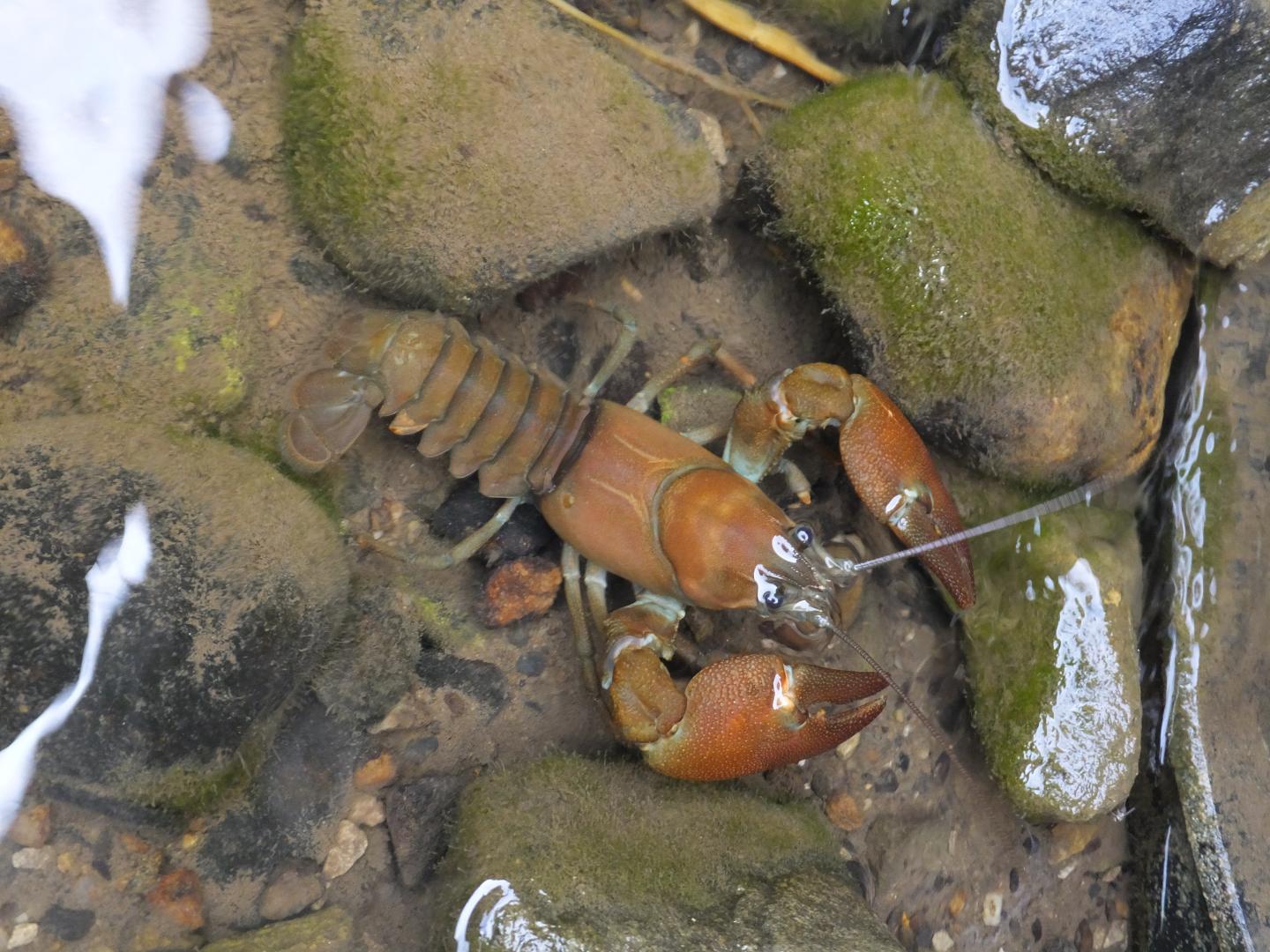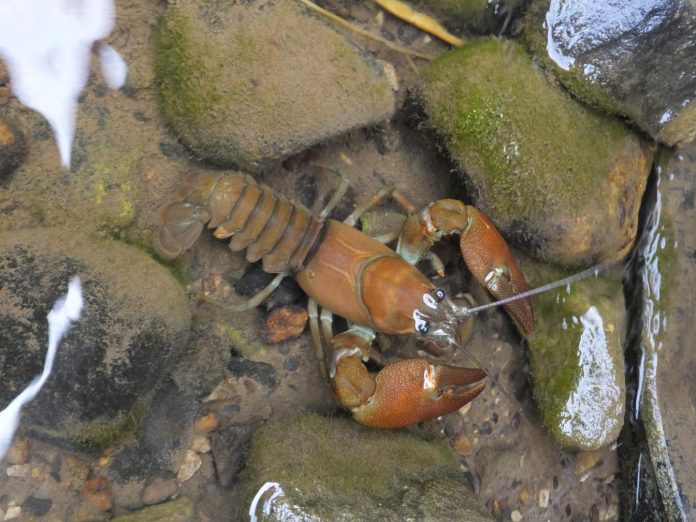
Photo: Despite being championed by a host of celebrity chefs, crayfish ‘trapping’ is not helping to control invasive American signal crayfish, according to new research by UCL and King’s College London….
view more
Credit Image: Eleri Pritchard
Despite being championed by a host of celebrity chefs, crayfish ‘trapping’ is not helping to control invasive American signal crayfish, according to new research by UCL and King’s College London.
There have been grave concerns within the science community and amongst conservationists that American signal crayfish are wiping out other species of crayfish across Europe – including Britain’s only native crayfish, the endangered white-clawed crayfish.
In their new study, published in the Journal of Applied Ecology, the researchers find that trapping is ineffective in determining and controlling signal crayfish numbers, as the vast majority of individuals are too small to catch using standard baited traps.
‘Trapping to eat’ American signal crayfish has been promoted as a potential control measure in recent decades, but scientists warn that this method may exacerbate the problem, as it inadvertently incentivises members of the public to spread the species to new habitats and greatly increases the risk of accidental catches of the strictly protected native species.
Co-author and PhD researcher, Eleri Pritchard (UCL Geography), said: “Invasive signal crayfish from the US were introduced to England in the 1970s. Since then they have spread rapidly, displacing native crayfish, impacting fish and damaging ecosystems.”
“While celebrity chefs and conservation charities have, with good intentions, promoted trapping and foraging as a way to control American signal crayfish, our research shows trapping to be ineffective. We are also concerned that trapping risks spreading the fungal pathogen, called crayfish plague, which is lethal to native European crayfish.”
The study took place in an upland stream in North Yorkshire, UK and compared the effectiveness of three methods used for surveying population numbers: baited funnel trapping, handsearching, and a novel ‘triple drawdown technique’, which involves draining a short section of stream in a carefully controlled way and calculating the number of crayfish present, including infants.
To measure effectiveness, scientists compared all methods for determining population size, and for understanding the prevalence of crayfish invasion and the ecological impact.
The triple drawdown technique proved significantly more accurate in determining crayfish populations. Through this method, the researchers identified signal crayfish densities up to 110 per square metre, far exceeding previous estimates for similar streams made by trap sampling.
The triple drawdown method also showed that most of the crayfish caught were tiny (smaller than a 1 pence piece), with only 2.3% of the population large enough to be caught in standard traps. Crucially, signal crayfish can become sexually mature before reaching a ‘trappable’ size, allowing populations to reproduce despite best efforts to control them through trapping.
Co-author and recognised UK crayfish expert, Paul Bradley (PBA Ecology), said: “We now have strong data to show that trapping does not help to control invasive crayfish. On the contrary, there is growing evidence that trapping furthers the spread.
“In the short-term, conservation efforts should re-focus on promotion of aquatic biosecurity, and in the longer-term we need further research to better understand the invasion biology of American signal crayfish. This will help to inform more effective and sustainable approaches to the management and control of this problematic invasive species”.
The scientists strongly recommend that recreational crayfish trapping be curtailed to prevent the further spread of these invasive species. They believe more focus should be placed on initiatives like the UK’s national ‘Check Clean Dry’ campaign, aimed at educating regular water users on the way that non-native invasive aquatic plants and animals can unwittingly be transported between waterbodies on contaminated clothes and equipment, as well as by fish stocking and water transfer schemes.
Dr Emily Smith, Environment Manager at Angling Trust, said: “Signal crayfish have a devastating impact on our waters, harming fish populations, increasing economic costs for fisheries and causing a nuisance for anglers.
“These findings present a new chapter in management practices, providing invaluable intelligence for fisheries and angling clubs, supporting them in refining practical solutions to controlling this highly aggressive species.”
The research was carried out with PBA Applied Ecology and funded by the Natural Environment Research Council through the London NERC DTP.
###
Notes to Editors
For more information or to speak to the researchers involved, please contact Natasha Downes, UCL Media Relations. T: +44 (0) 20 3108 3844 / +44 (0) 7990 675 947, E: [email protected]
Daniel D. A. Chadwick, Eleri G. Pritchard, Paul Bradley, Carl D. Sayer, Michael A. Chadwick, Lawrence J. B. Eagle & Jan C. Axmacher, ‘A novel ‘triple drawdown’ method highlights deficiencies in invasive alien crayfish survey and control techniques’ will be published in Journal of Applied Ecology on Tuesday 13 October 2020, 05:01 UK time.
DOI will be: 10.1111/1365-2664.13758
URL will be: https:/
Images and credits are available here: https:/
About UCL – London’s Global University
UCL is a diverse community with the freedom to challenge and think differently.
Our community of more than 41,500 students from 150 countries and over 12,500 staff pursues academic excellence, breaks boundaries and makes a positive impact on real world problems.
We are consistently ranked among the top 10 universities in the world and are one of only a handful of institutions rated as having the strongest academic reputation and the broadest research impact.
We have a progressive and integrated approach to our teaching and research – championing innovation, creativity and cross-disciplinary working. We teach our students how to think, not what to think, and see them as partners, collaborators and contributors.
For almost 200 years, we are proud to have opened higher education to students from a wide range of backgrounds and to change the way we create and share knowledge.
We were the first in England to welcome women to university education and that courageous attitude and disruptive spirit is still alive today. We are UCL.
http://www.
Find out how UCL is helping lead the global fight against COVID-19 http://www.















